
The Way Home Photos with Captions

Retreat
Baffin Island, Nunavut, 2007
Throughout the Arctic, glaciers are retreating at a startling rate, and these visibly diminishing rivers of ice are poignant and unmistakeable evidence of our warming atmosphere. At current rates of global warming, two-thirds of the world’s glaciers are projected to disappear by the end of this century. The continued use of fossil fuels is hugely problematic for the climate, for the biosphere, and for humanity.
Unfortunately, carbon emissions are tightly correlated 1:1 with GDP and population growth. Together they go up in lockstep. Our culture has a built-in growth mandate, our economy is optimized for profits, and the industrial world remains dependent upon the unmatched power density of fossil fuels. As a result, emissions continue to rise.
This situation will not change until there is a reorientation of what industrial society values and prizes most highly. In 2022 the world consumed nearly 55 percent more fossil fuels than it did in 1997, when delegates from nearly 200 nations met in Kyoto to agree on commitments to limit the emissions of greenhouse gases.
As distinguished energy analyst Vaclav Smil says, "Since the world began to focus on the need to end the combustion of fossil fuels, we have not made the slightest progress in the goal of absolute global decarbonization."

A New Generation of Leaders
Ilulissat, Greenland, 2011
Aayu Peter represents a new generation of Indigenous leaders who do not confuse being “modern” with being “Western.” She is a hunter; a lawyer; a sealskin clothing designer; a musician; a recording artist; the subject of numerous documentary films; and a Member of the Order of Canada. Aayu is a powerful spokesperson for Inuit involvement in issues relating to Arctic resource management and Inuit rights.
Aayu proudly wears one of her modern sealskin creations. Her visage is decorated with a Tunnitt, the beautiful and ancient traditional women’s facial tattoo. For over a century, tunnitt had been forbidden by the Canadian government.
"The true North Star is the self-determination of Indigenous Peoples and our ability to make decisions on any projects that have the potential to impact our lands and territories. It is time to change the old approaches and to center Indigenous leadership," says Galina Angarova, a Buryat from the Lake Baikal region of Siberia.
Natural resource development on indigenous lands, increasingly including massive renewable energy projects such as Norway's Fossen Vind built on traditional Sami reindeer pasture land, can perpetuate extractivist practices and reinforce power imbalances, perpetuating a colonial dynamic where distant, external entities pursuing their own agendas benefit financially from the resources while the local communities absorb the costs.

Last Days Of The Great Ice
Disko Bay, Greenland, 2014
Sermersuaq, The Greenland Ice Sheet, spans 660,000 square miles — an area almost the size of Alaska. It is nearly 2 miles thick at its height, and if it melts it has the potential to raise the world’s oceans by more than 20 feet. Today, The Greenland Ice Sheet loses 30 tons of ice every hour.
As if to underscore the existential threat the loss of Sermersuaq, which means “The Great Ice” in Kalaallisut, poses for the entire planet, an iceberg calved from the Jakobshavn Glacier drifts under threatening skies. Out of the foreboding dark shadows, a ray of bright sunlight breaks through and strikes a portion of the iceberg, reminding us that the time to change our course is fleeting.
Please pause to consider that in the year of the Rio Earth Summit - 1992 - when the world's leaders promised to stop climate change, fossil fuels provided 81 percent of the world’s primary energy. After more than three decades of attempted progress and trillions of dollars invested in alternatives, fossil fuels now account for 82 percent of global primary energy.
Richard Heinberg outlines the choice we face when he asks, "The question is, shall we choose to gradually accustom ourselves to another way of life — one that more successfully integrates human purposes with ecological imperatives — or shall we cling to our present choices to the bitter end?"

Massive Iceberg Looming Over Qeqertarsuaq
Qeqertarsuaq, Disko Island, Greenland, 2014
Under dark and threatening skies, a massive grounded iceberg looms above the village of Qeqertarsuaq. As large as it appears, nine-tenths of the iceberg is underwater. This iceberg calved from Sermersuaq - “The Great Ice,” or the Greenland Ice Sheet, via the Jakobshavn Glacier, the source of the iceberg that sank the Titanic. The Jakobshavn Glacier is retreating rapidly, calving 35 billion tons of ice each year, which means it discharges more fresh water into the ocean in a single day than New York City uses in an entire month. The rate of discharge has doubled in the last decade.
These are the times we live in, and we must work out how to live in them. Icebergs have been spotted dead ahead. Are there other courses we can chart that avoid the danger and lead to different outcomes? Are we mere passengers, passively watching our captains maintain a collison course towards growth and thus necessarily ever rising carbon emissions?

Arctic Dreams
Akpatok Island, Ungava Bay, Nunavut, Canada, 2008
A large block of ice, melted and polished by the sun and the sea, lies stranded on the shore of a remote Arctic island. With sunlight pouring through a window in the ice, this natural sculpture presents us with a poignant reminder of sea ice loss and a vision of melancholy beauty.
Despite thirty-six international climate conferences and trillions of dollars of investment in alternative energy over the last few decades, consider this: more carbon has been emitted just since the first global environmental summit in 1992 than in all of human history prior to that point.

The Face of Climate Change
Lower Savage Islands, Nunavut, Canada, 2011
The changing climate means that the Arctic Ocean freezes later in the autumn and melts earlier in the summer than it used to. When the sea ice retreats during the summer, polar bears can find themselves stranded on remote islands with no way of procuring food for months until the sea freezes again.
There was no turning away from this heartbreaking moment. I saw the bear watch a seal swimming nearby in open water, so close yet out of reach. With freeze-up still weeks away, this starving polar bear was in a precarious situation.
The world struggles to rein in carbon emissions. But as Gus Speth, President Carter’s chairman of the Council on Environmental Quality and the co-founder of the Natural Resources Defense Council wrote recently, “There is a new struggle that needs to be joined now: the struggle to learn from our mistakes — the Big Mistake of climate catastrophe. What is it about our society, our economy, our politics, and our culture that has let this giant failing happen? What is it that has led us to this tragedy?”

Decision Point
Disko Island, Greenland, 2014
Giant icebergs calved from the glaciers of northwestern Greenland bear witness to the accelerating melting of Sermersuaq - The Great Ice.
It is well-known that burning fossil fuels is warming the atmosphere and must stop, but here is the problem: a single barrel of oil contains 5.8 million British Thermal Units’ (BTUs) worth of energy — which is equivalent to more than 5 years of one human’s labor — and since the world consumes over 100 billion barrels of oil each year, oil provides us with the labor equivalent of more than 500 billion human workers annually.
In our quest for perpetual economic growth, will we ever be willing to voluntarily dismiss these essential workers and give up the magic power of oil? As Jevon’s Paradox posits, the more efficient a source of energy, the more of it we will use, and there is no more efficient source of energy than oil. Since the 1990s we have increased our energy efficiency by 30 percent, but we have also increased our energy consumption by 70 percent. This is why, despite our best efforts and intentions, the temperature continues to rise every year. And this is why, despite trillions of dollars invested, wind and solar power contributed only 2.4 percent of world energy consumption in 2022 -- essentially a rounding error.
Humanity is at Decision Point. There is no more time to wait. We must chart our course into the future now.
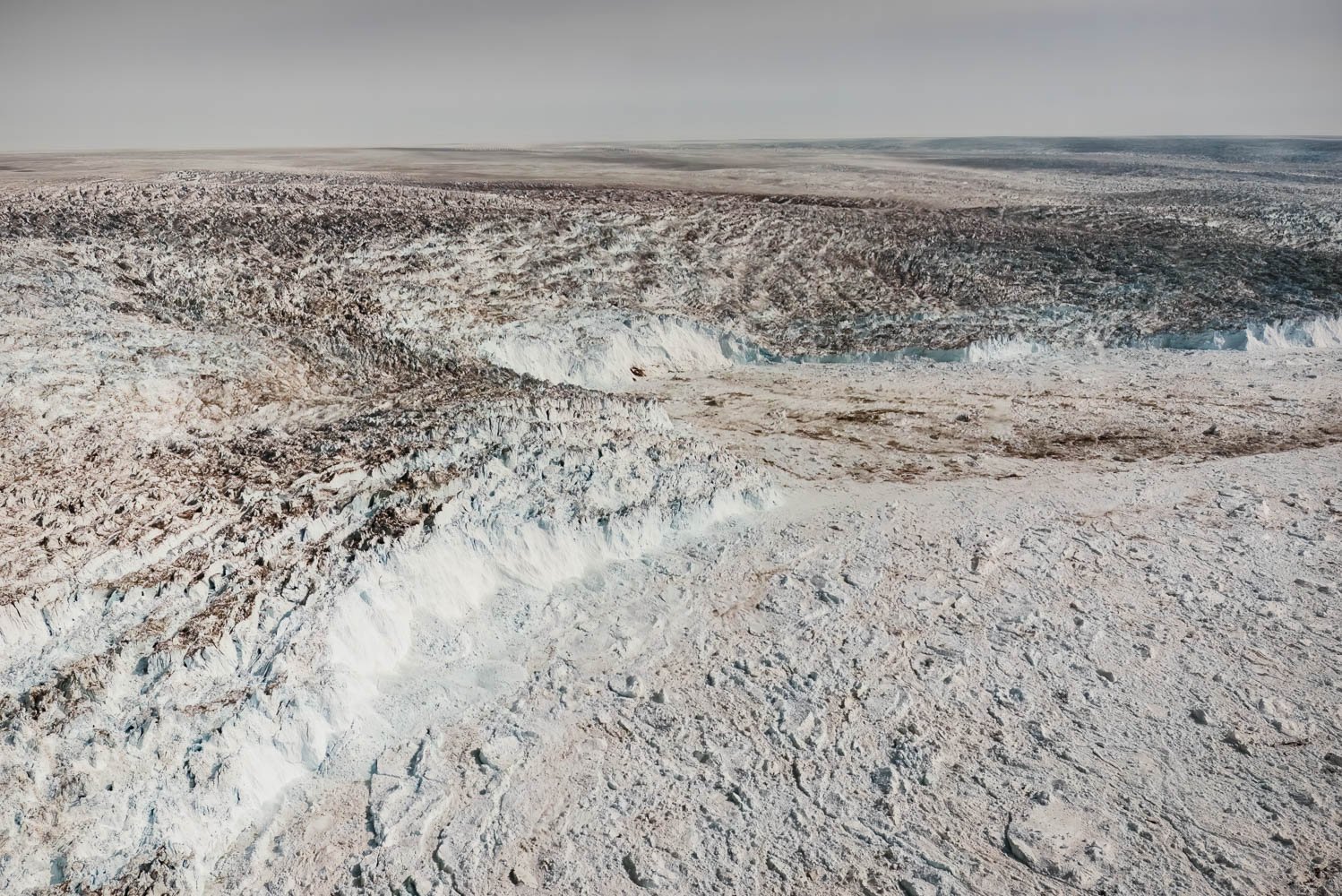
Dark Ice on the Jakobshavn Glacier
Ilulissat, Greenland, 2014
Air pollution from around the world is carried by the jet stream and deposited on the vast Greenland Ice Sheet and its extensive floating ice shelves. In a perfect feedback loop the particulates combine with blooms of pigmented microalgae to darken large areas of the formerly bright white surface and accelerate the melting of the ice.
The most recent scientific studies show that Greenland's glaciers are melting 100 times faster than previously estimated, and that the ice shelves in northern Greenland have lost more than a third of their volume just in the last half-century because of pollution and rising temperatures.
The crucial challenge facing modern industrial society is that it is intrinsically an oil culture. It is shaped by oil in physical, material, and even metaphysical ways. From the trucks, automobiles, and highways we use, to our food supply, to our built environments, to our expectations of the future, oil is the master resource. As a result of this indispensable central role in all aspects of our lives, oil has also shaped our cultural values, practices, and beliefs.
One way or another the petroculture is ending, and unless we change our ways voluntarily, ultimately it is geology that will determine our future on a planet of depleting resources. “2025 and beyond is when the world is going to be short of oil,” says Vicki Hollub, chief executive of Occidental Petroleum. We have built our civilization on cheap, easily accessible oil, and when it is no longer available, that civilization contracts and eventually stops.

Dark Cloud and Sled at the Floe Edge
Bylot Island Floe Edge, Nunavut, Canada, 2013
Dramatic atmospheric conditions prevail at the floe-edge where the shore-fast sea ice meets the open water of Baffin Bay. “Everything is connected through our common atmosphere, not to mention our common spirit and humanity. What affects one affects us all… The future of Inuit is the future of the rest of the world - our home is a barometer for what is happening to our entire planet.” - Sheila Watt-Cloutier, Nobel Peace Prize Nominee and former chair of the Inuit Circumpolar Conference
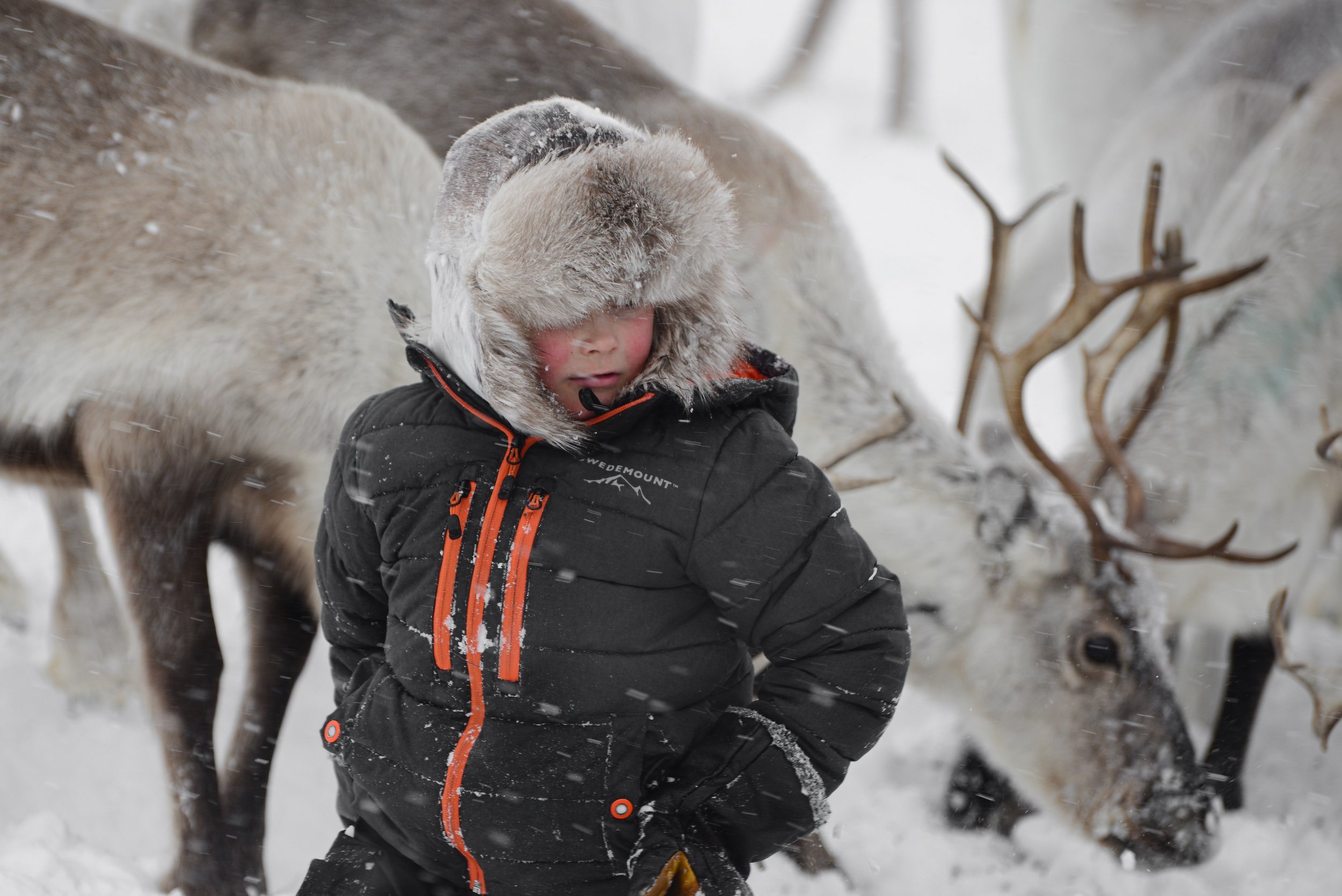
Sami Boy and Reindeer
Finnmark Plateau, Arctic Norway, 2022
From a very young age, Sami children spend time with their family’s herd out on the land, learning timeless cultural skills and traditions. Throughout the Arctic indigenous peoples maintain a strong connection to the environment through hunting, herding, fishing, and gathering renewable resources. These cultural practices provide the basis for most of their food production and have endured over thousands of years.
Our global predicament is a cultural crisis, and that requires a cultural response. Fortunately we have one. For millennia the Inuit and Sami ways of life have been models of sustainable living in an interconnected, vibrant, and enchanted world. Stepping outside our culture and into theirs is quite revealing, and the contrast is stark.
“Climate change is a complex issue, standing at the crossroads of science, ethics, society, education and, of course, culture – a dimension that has for too long been undervalued.” - UNESCO

Clarity at The Margins
Puvirnituq, Nunavik, Canada, 2011
Traveling on the sea ice and living and working in the extreme Arctic environment requires specific knowledge and special skills passed from generation to generation. Traditional Inuit ways of thinking and being are based in cultural beliefs, lived experience, and acquired wisdom, and today these cultural traditions are being challenged by an intruding global industrial culture that is threatening their way of life and their environment.
“It is at these margins of society that it is possible to see with surprising clarity our centre”, writes Arctic anthropologist Hugh Brody. “On colonial frontiers, where different and often rival ways of living meet, the underlying elements of our society become more clearly visible, sadly in exaggerated form.”
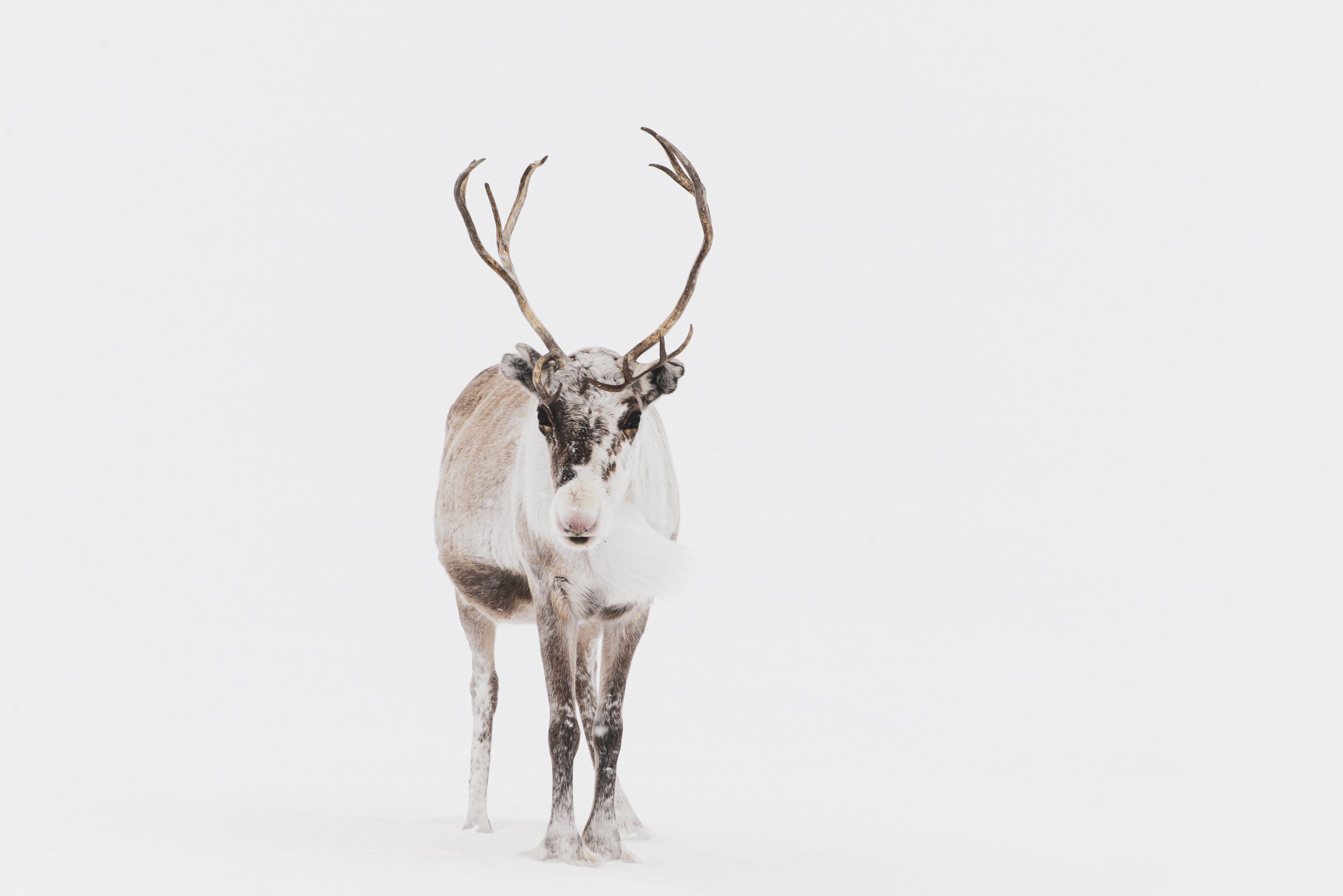
The Summons
Finnmark Plateau, Arctic Norway, 2022
I had a dream one evening in the winter of 2022, the night before my exhibition with Edward Koren, Down to the Bone, was to open. In my dream, a lone reindeer appeared out of an Arctic whiteout and looked directly at me. Then the reindeer delivered a message: Come visit us. Come hear our story. A month later, while traveling with Sami herders across Arctic Norway’s Finnmark Plateau in a whiteout, I turned around, and the reindeer appeared to me once again, just as in my dream.

Inummarik - "A True Inuk"
Puvirnituq, Nunavik, Canada, 2011
Inummarik means “a true Inuk;” someone who is culturally skilled, knowledgeable, and a guiding source of wisdom for younger generations. In a time of dramatic environmental, technological, and cultural challenges, Inummarik strive to pass language, culture, traditional beliefs, skills, and worldviews on to Inuit youth so that they may have a framework for living a good life in harmony with nature that is full of purpose and meaning. Inummarik wisdom does not apply only to Inuit, it is universal.

Waterfall and Stranded Polar Bear
Akpatok Island, Nunavut, Canada, 2011
A stranded polar bear spends the summer wandering the shore beneath 800-foot-high limestone cliffs. The warming climate means that the sea ice forms later in the fall and melts earlier in the spring, meaning polar bears must live off their body’s fat reserves when there is no sea ice and thus no access to seals.
While on land the bears are starving, losing roughly two pounds per day. They scavenge berries, seabird eggs, scurvy grass, and kelp while stranded, but none of these foods are fatty or abundant enough to sustain them over the long-term.

Vitality, Creativity, and Autonomy
Finnmark Plateau, Arctic Norway, 2022
“Science and technology reign today as the practical gods of the modern age; they give us power to disrupt nature but little real insight into how it functions… Only when we look outside Western culture, or when someone outside looks in, do we discover the glaring inconsistencies and begin to measure the actual changes that science and technology have wrought in our lives.” - Vine Deloria Jr.
Sami, Inuit, and the thousands of distinct place-based human cultures still fighting for survival reject the unquestioning acceptance of what Lewis Mumford called authoritarian technologies. They view the power of science and technology with a critical eye, and they remind us of the immense vitality, creativity, and autonomy that their humane, sustainable, egalitarian, and truly democratic traditions still offer us.
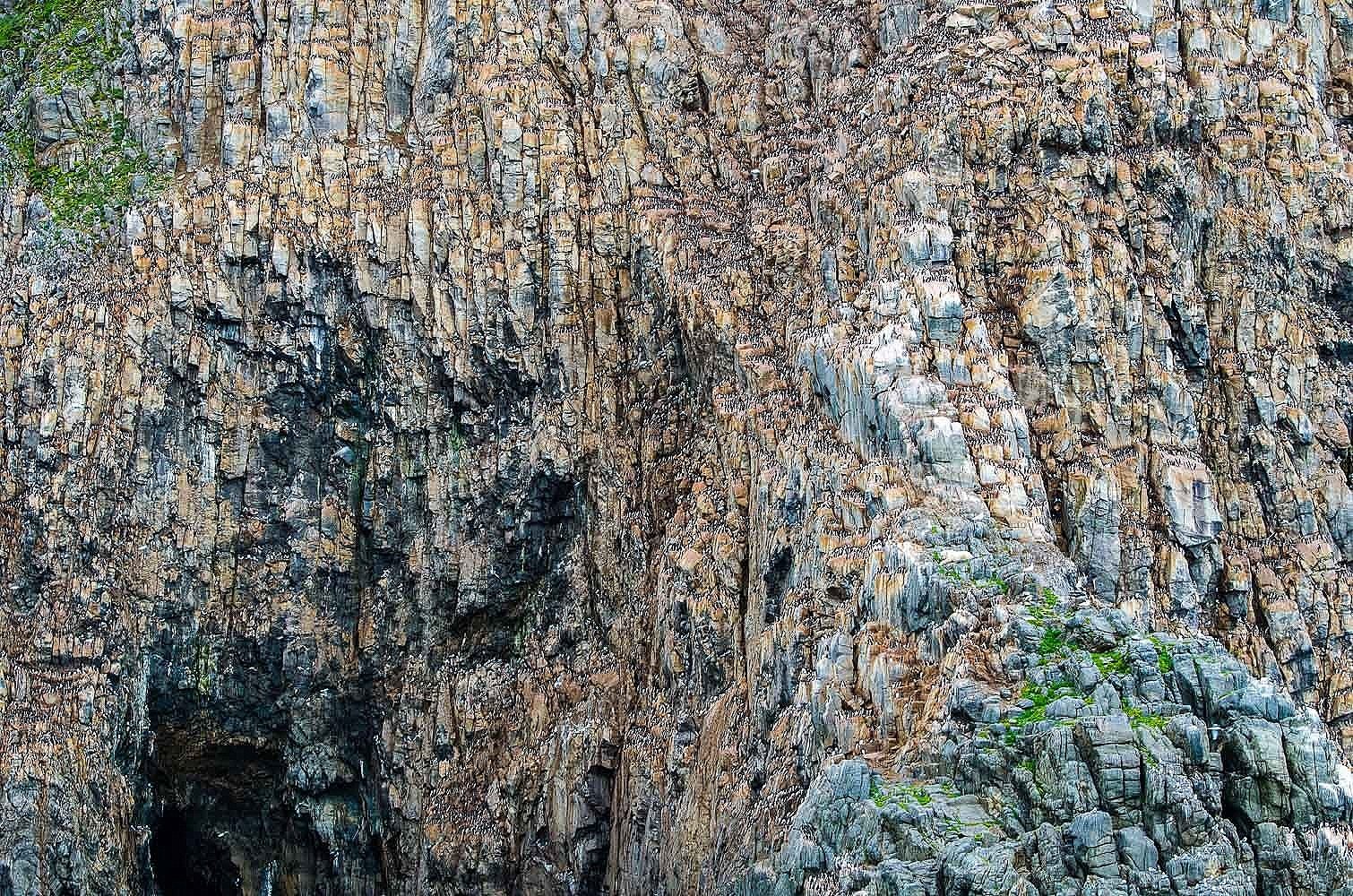
Intrepid, Innovative, and Resilient
Coburg Island, Nunavut, Canada, 2012
Marooned on land, unable to hunt seals, polar bears have occasionally been reported scavenging for eggs, dead birds, and fallen fledglings at the base of nesting cliffs as they searched for supplemental food during the ice-free season. Polar bears are not known to scale cliffs in search of food, but this intrepid, innovative, and resilient bear did just that, climbing a couple of hundred feet up the rock wall to access the plentiful birds and eggs in this seabird rookery.

Irony On The Plateau
Finnmark Plateau, Arctic Norway, 2022
As they have for centuries, reindeer and their Sami herders migrate across northern Scaninavia from the coast to the interior and back again, completing their timeless annual cycle.
And as they have for centuries, Arctic Indigenous communities continue to experience stress from powerful outside political and industrial forces that threaten to restrict culturally vital harvesting and herding activities and to sever the powerful bond between the people and the land.
Ironically, the energy transition designed to stop climate change is threatening the sustainable and environmentally friendly way of life of the Sámi, Europe’s last-remaining Indigenous people who are indeed models of low carbon living.
Rather than learn from the Sami, European governments are eyeing their lands for giant industrial wind installations and for mines rich in rare minerals for electric vehical batteries. The Sami call this acquisitive approach to their lands “green colonization.”
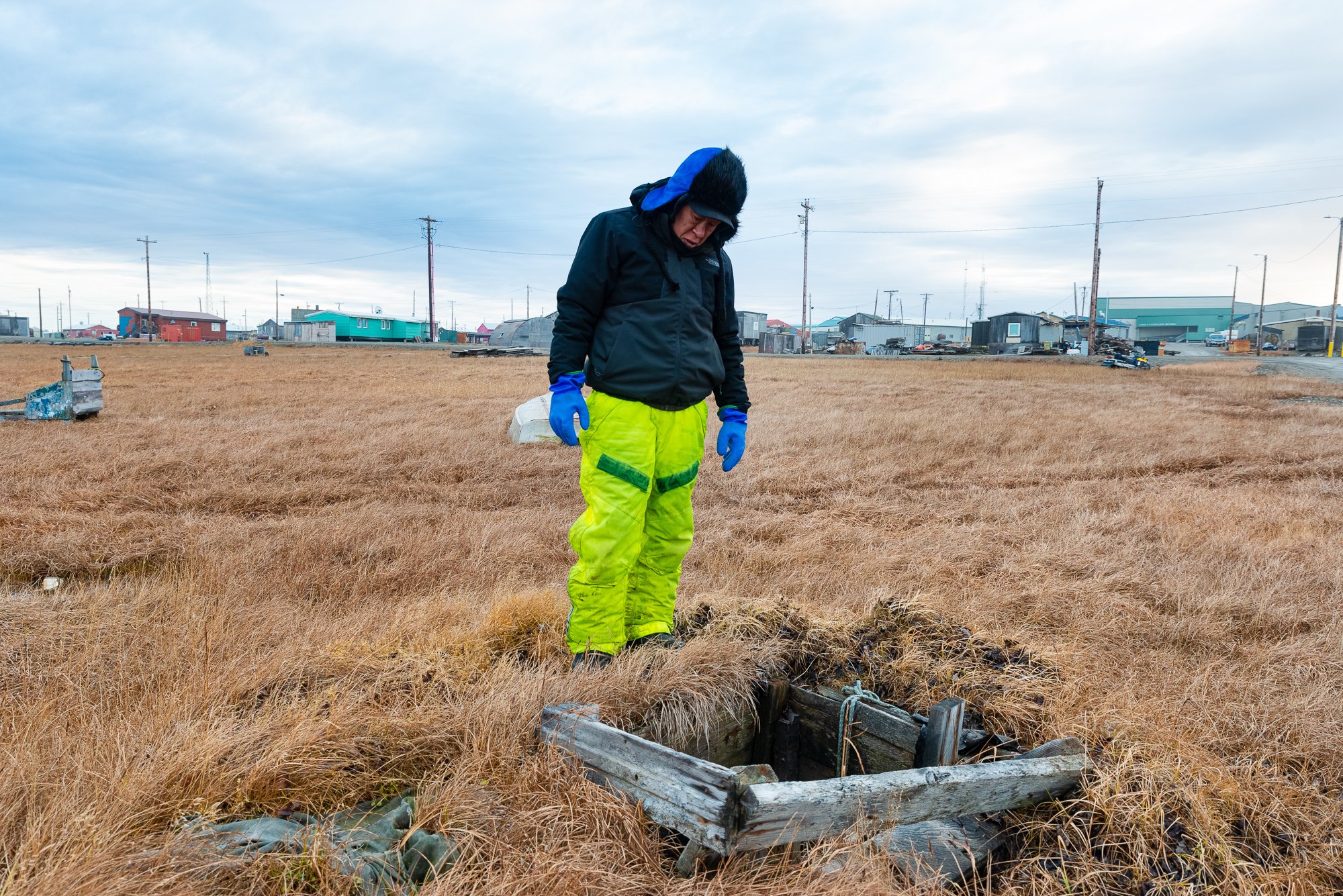
Melting Ice Cellar
Kaktovik, Alaska, 2017
Jack Kayotuk, a resident of the Inupiat village of Kaktovik on Barter Island in the Beaufort Sea off the north coast of Alaska, examines a melting ice cellar where the villagers once stored whale meat from the annual bowhead whale hunt. Dug deep into the permafrost, the cellars kept the meat frozen throughout the year. Today the permafrost is melting, rendering the cellars unsafe for food storage.
Scientists have been warning that the Arctic is heating twice as fast as the rest of the planet. However, the most recent studies show that the Arctic is actually warming at four times the global average, and that the portion of the planet above the Arctic Circle — the area located above 66.5 degrees latitude — has warmed by more than 5 degrees Fahrenheit since 1979.
Unfortunately, when we add new energy sources to the system we don't replace older sources, we merely add to our capacity to grow our energy consumption. Though the world switched from wood to coal to oil as primary energy sources over the last century and a half, we still burn more wood today for energy than we did 150 years ago.
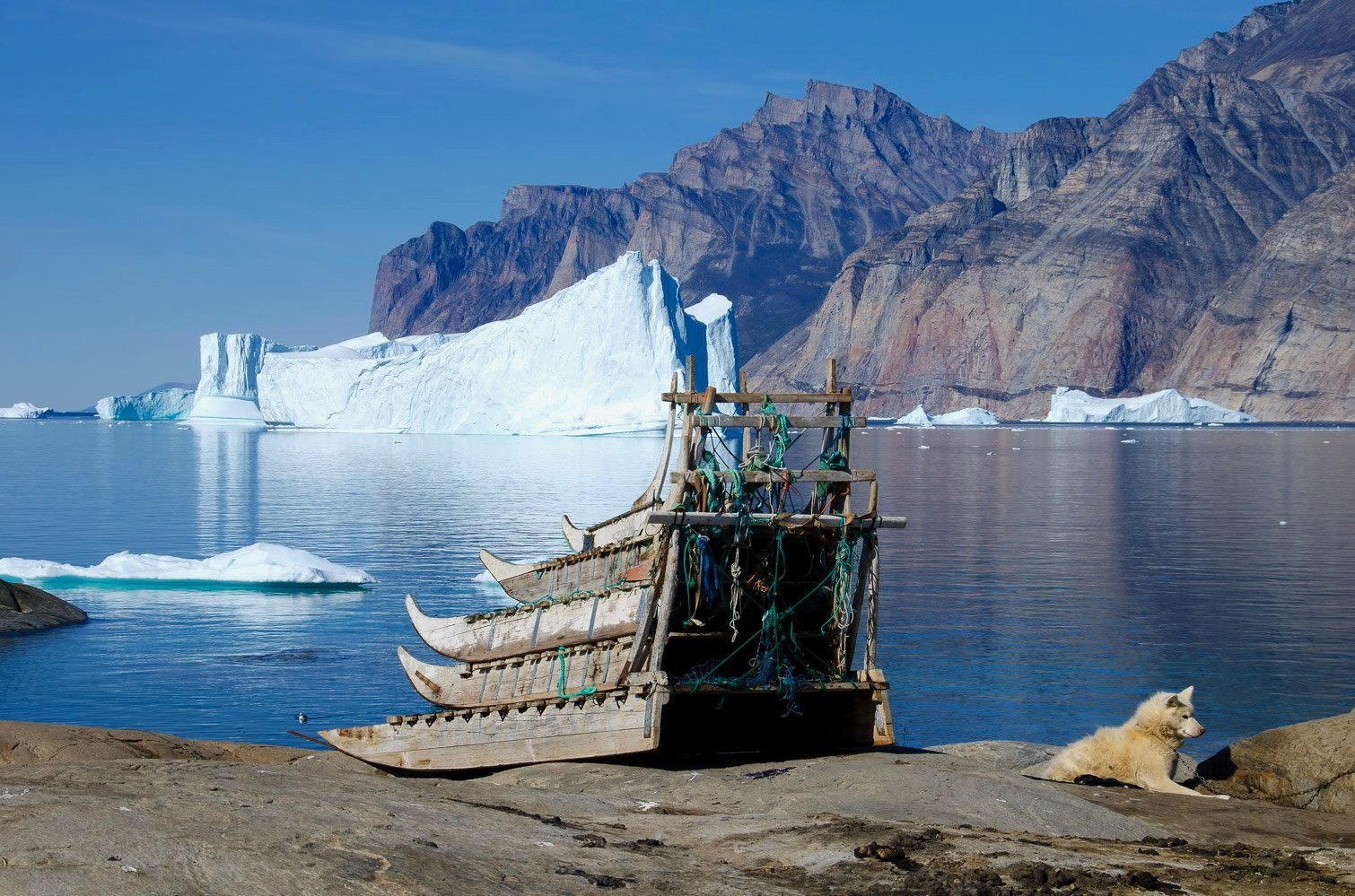
Sikuvut Nunguliqtuq - "Our Ice is Vanishing"
Sattut, Greenland, 2014
Dogsleds and a sled dog wait patiently for freeze-up so they can venture out onto the sea ice once again. Just as the polar bears need a platform of sea ice to hunt seals at their breathing holes, Inuit culture is adapted to the sea ice environment. The ice permits mobility and flexibility, and hunting cultures must always be ready to move and seize new opportunities, for no two years are ever alike, animal migration patterns change, and “the world is in a constant state of coming into existence at all times” (Pinngortitaq).
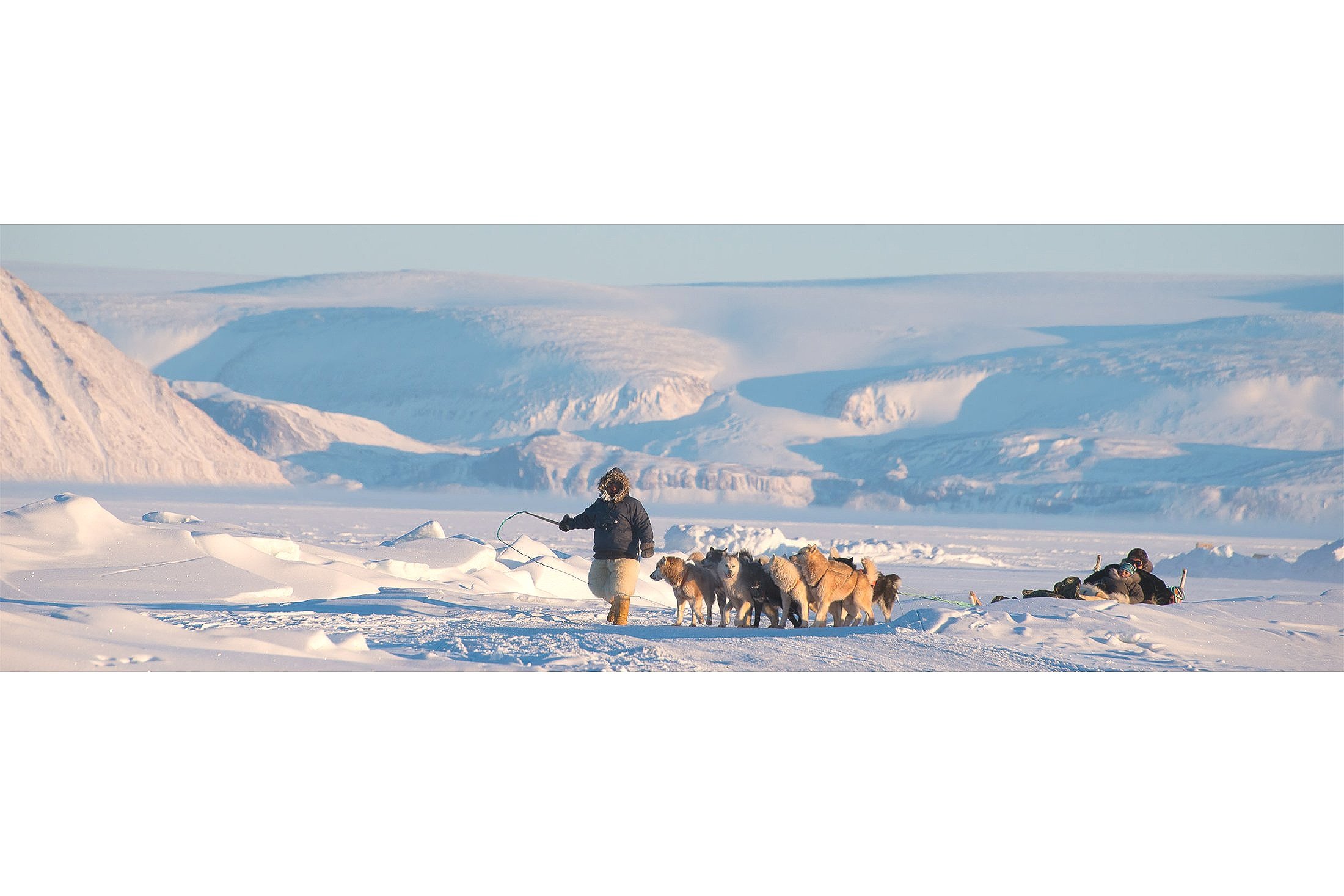
Inuit Qaujimajatuqangit
Qaanaaq, Thule, Greenland, 2017
Inuit Qaujimajatuqangit (or simply IQ - ”What Inuit have always known to be true”) means the cultural wisdom gained from extensive experience, passed from generation to generation.
“It also means knowledge of the Arctic environment - of snow, ice, water, weather and the environment that we share. It encompasses being in harmony with people, land and living things - and respecting them. It implies life skills, alertness and the ability to train others for a strong healthy life. It provides purpose and meaning for us and is a way of being in the world that our ancestors set down for us to ensure our survival and well-being.” - Mark Kalluak, Nunavut
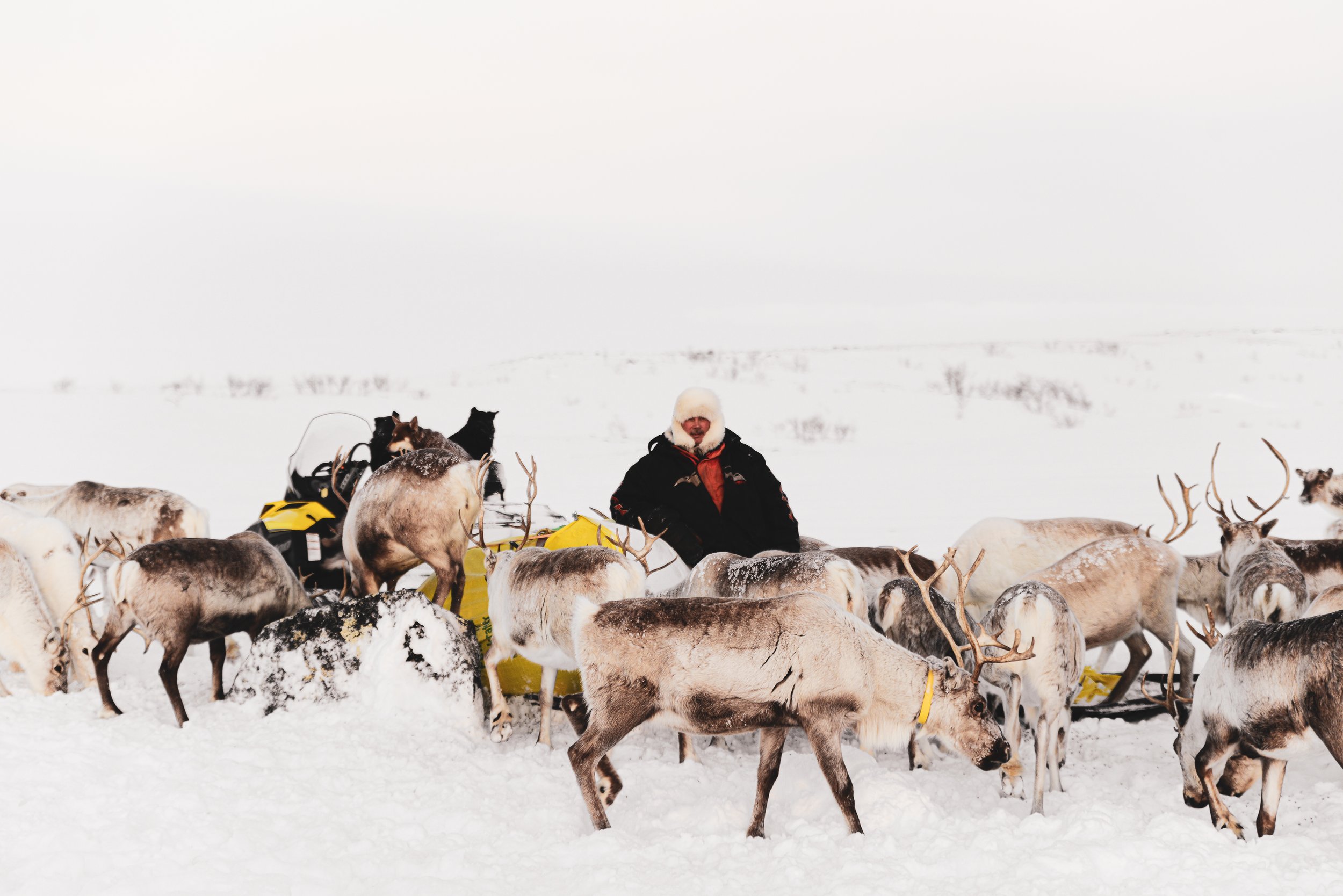
A Special Relationship
Finnmark Plateau, Arctic Norway, 2022
A Sami reindeer herder and his dogs take a rest from the migration as the herd mills around them. For hundreds of years, the reindeer have provided the Sami with food, clothing, shelter, and materials. And as it has for hundreds of years, most reindeer herding in Norway takes place on the Finnmark Plateau north of the Arctic Circle.
Herders follow the same migration paths from the coast to the interior from year to year, and while each family has its own pastures, all of the land is held in common. Sami herders each have their preferred areas, but with the changing climate and deteriorating conditions, it is widely accepted that families may need to share their traditional pastures. In the winter on the plateau the reindeer live on lichen, which is buried under the snow and can be difficult if not impossible for them to access after a Cuohki event, when rain on pastures freezes and forms an ice sheet sealing in the lichen.
Today, with wildly fluctuating winter temperatures, even the Finnmark Plateau at 70 degrees north latitude is regularly experiencing dangerous thaws and freezes.

Independence
Thule, Greenland, 2017
Inughuit subsistence hunters travel the sea ice by dogsled in search of seals, walruses, and polar bears. The hunters of northern Greenland depend upon wild game for roughly 80 percent of their diet. By using traditional technologies that they both manufacture and control such as dogsleds, the Inughuit retain their culture and independence, insulating themselves from the need for expensive modern commercially manufactured tools and dependence upon distant, unreliable six-continent supply chains.
Historian David Fleming summarized this approach to living on a planet of finite resources when he wrote, “Localisation stands, at best, at the limits of practical possibility, but it has the decisive argument in its favour that there will be no alternative.”

Breaking Away
Ilulissat Ice Fjord, Greenland, 2014
Ice calved from the Jakobshavn Glacier drifts into Disko Bay. The rapid warming of the Arctic creates ripple effects all over the planet. As a result, once-stable sea levels are rising, weather patterns are shifting, and ecosystems around the world are changing.
"Beyond policy changes and investment, a seismic cultural shift is imperative to steer humanity away from self-destruction towards a just and sustainable future. We must realign our political will, economic priorities and societal values to recognise that ecological wellbeing is matched to human wellbeing." - Sir David King, Chair of the Climate Crisis Advisory Group
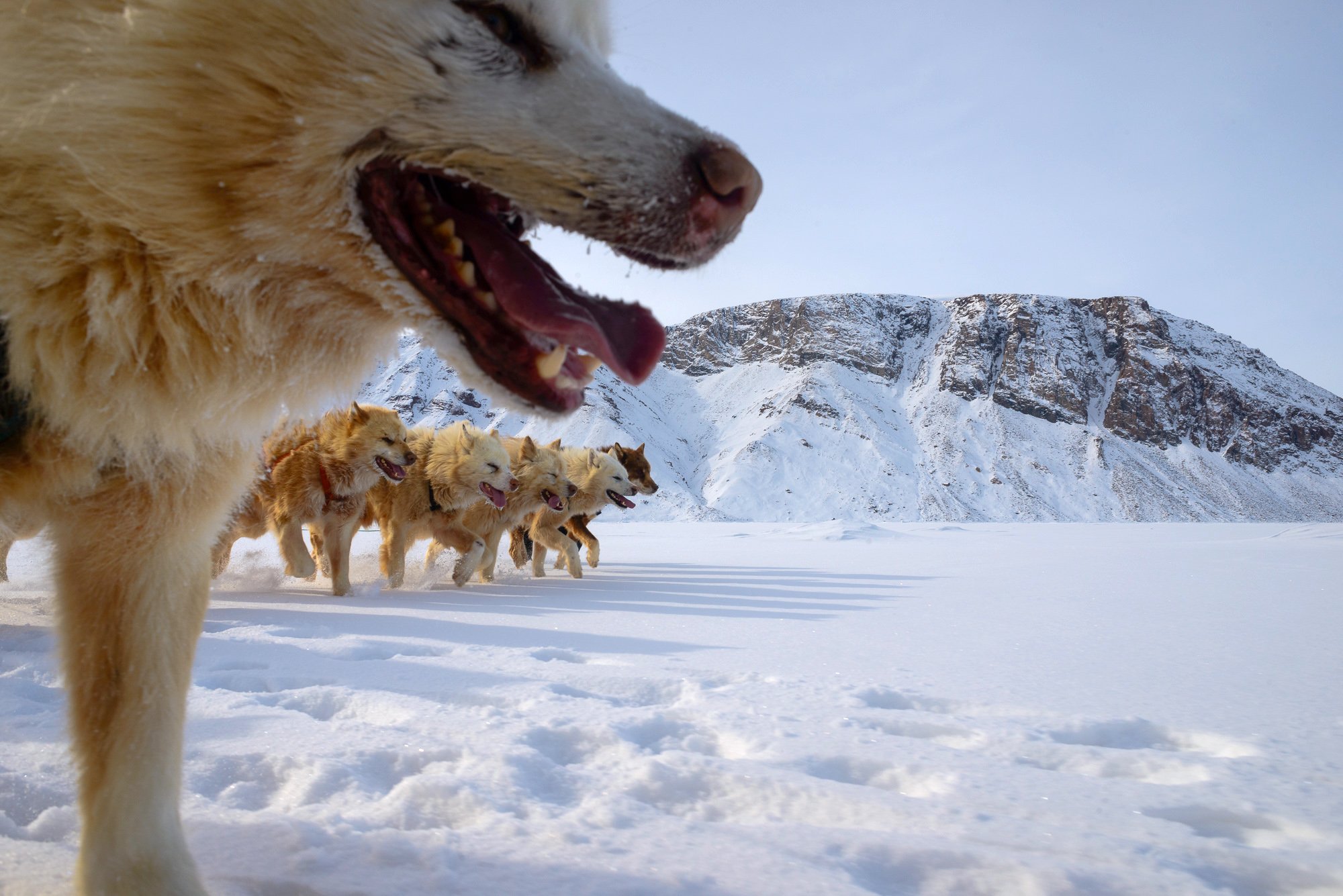
Sled Dog Culture
Thule, Greenland, 2017
Northern Greenland is home to the largest sled dog population in the Arctic, and the Inughuit, or Polar Inuit, take pride in their unique and vibrant sled dog culture. The Greenland sled dog is the oldest breed in the world, having migrated with the Inughuit on their 4,000 year journey across the Arctic from Alaska to Greenland. To preserve their extraordinary culture, the Inughuit have made the choice to not allow the use of snowmobiles in their homeland.
Today however, both the Greenland sled dog and the ancient sled dog culture are in danger of disappearing due to both climate change and powerful political, economic, and development pressures that, in a very old story, would like to see the independent Indigenous population off of the land in order to develop it.
Inughuit elders fear that the sled dog culture, with its embodied wisdom that has sustained them for at least the last 4,000 years, will be gone in a generation.

Resistance
Qaanaaq, Thule, Greenland, 2017
A contemporary Inughuit hunter leads his dog team onto the sea ice to begin a hunting expedition. “Hunters and gatherers stand at the opposite pole from the dense urban life experienced by most people; yet those same hunters may have the key answers to some of the central questions about the human condition: Can people live without the state or the market? Can people live without accumulated wealth or “advanced” technology? Can people live in nature without destroying it?” - Richard B. Lee

A Familiar Story
Finnmark Plateau, Arctic Norway, 2022
Before the 17th century and the colonial intrusion into Sami territory by the emerging nation states of Scandinavia and Russia, the Sami were hunter gatherers. They harvested wild reindeer for food, clothing, shelter, and tools. Their needs were few and easily met. When their lands were taken from them by colonial authorities, the Sami began domsticating the wild reindeer and increasing the size of their herds in order to pay taxes to the new governments with hides.
Since the 1600s, in a story familiar to virtually every indigenous and place-based people on the planet, the Sami have endured centuries of forced assimilation, uprooting, relocation, abuse, and the systematic loss of their language and culture. Even today, after a recent report issued by Norway’s Truth and Reconciliation Commission detailed centuries of government wrongdoing and complicity, little has changed as industrial development continues to threaten the traditional Sami lands, waters, and way of life.
Unfortunately, around the world colonial powers are once more eyeing Indigenous lands. As Galina Angarova, herself a Buryat from Siberia, points out, "Indigenous Peoples are increasingly experiencing the impacts of the transition to the green economy as the world accelerates its quest for resources. Targeting the lands of Indigenous Peoples for exploration and exploitation without consultation and consent has been ongoing for the past 500 years."

Siulersortaat - “Those Who Guide The Way"
Inglefield Fjord, Thule, Greenland 2017
For thousands of years, Inuit have hunted the sea ice for food, clothing, and other essential uses. In Northwest Greenland, Inughuit hunters still wear sealskin boots, polar bear pants, and caribou parkas because these materials are locally available, sustainably harvested, do not require participation in the cash economy to procure, and are superior to any manufactured clothing for use in the harsh Arctic environment.
These hunters are respected for their foresight, leadership, experience, and insight. Hunters are siulersortaat - “those who guide the way.” Hunting remains a crucial part of Inuit cultural identity and satisfies many important social, cultural, economic, and nutritional needs of families, households, and communities.

Isuma - "Possessing Knowledge and Wisdom"
Gjoa Haven, King William Island, Nunavut, Canada, 2009
A little Inuit girl stands in front of drying muskox and grizzly bear hides in Gjoa Haven, on King William Island in the Northwest Passage. The grizzly hide is evidence of a warming climate, as King William Island was well north of their range until recently. During his first-ever transit of the Northwest Passage from 1903-06 aboard the Gjoa, Norwegian explorer Roald Amundsen spent two years here learning the Inuit survival skills and intimate knowledge of the polar environment that enabled him to become the first person to reach the South Pole.
Here among Inuit Amundsen developed Isuma - “the knowledge and wisdom to successfully navigate new and unexpected circumstances.” His rival, Captain Robert Scott of the British Royal Navy, refused to adopt Inuit wisdom in his quest for the Pole, and Scott and all of his men perished on their journey. The planetary emergency is largely the legacy of a lack of Isuma - the industrial development of a finite planet, the commodification and abuse of nature, and the decline of rooted and local ways of knowing and being. What can we learn from Inuit, Sami, and others like them, and can we develop Isuma as we head into the uncharted territory of planetary overshoot?

Homeward Bound -- Fresh Tracks Upon The Sea Ice
Thule, Greenland, 2017
An Inughuit hunter drives his dogsled over the snow covered sea ice near the village of Siorapaluk, the world’s most northerly community. The Inughuit were first contacted by Europeans in 1818, when British naval officer John Ross led an expedition searching for the Northwest Passage into their territory.
Until that encounter the Inughuit had lived for centuries in total isolation, completely unaware of the existence of other humans. In April 1909, American explorer Robert Peary depended upon Inughuit drivers and their dogsleds on an expedition that claimed to be the first to have reached the geographic North Pole.

Witnesses and Messengers
Eclipse Sound, Nunavut, Canada, 2013
At midnight in June, an Inuit sled navigates the melting ice of Eclipse Sound separating Baffin Island and Bylot Island in the Canadian High Arctic. The ice is vital to Inuit because it allows them the mobility to pursue their way of life.
Since Inuit live on a platform of ice, and they are daily immersed in their environment, they are the witnesses and messengers (silaup aalaruqpalianigata tusaqtittijiit) to the rest of us. They are telling us that the ice is melting and becoming more dangerous, and that this has both local and global consequences.
From physics to biology, the Indigenous worldview of interconnection and cooperation among natural systems is confirmed by scientific evidence. Can the rest of us adopt this worldview and align our behavior with biophysical reality in time to avert catastrophe?

Sami Woman and Child in Migration Camp
Finnmark Plateau, Arctic Norway, 2022
Sami are recognized as Europe’s only Indiginous culture. They number around 80,000 people scattered across their roughly 150,000 square mile territory in the northern parts of Norway, Sweden, Finland, and the Kola Peninsula in Russia (a homeland they call Sápmi). For centuries those countries suppressed their languages and forced Sami to assimilate culturally while dispossessing them and opening their lands for settlement and development.
Their challenges continue. Today Sami must fight to protect their lands against the extractive industries and to protect their migratory routes from industrial development. The European Union is coveting resources on Sami lands as they are deemed critcal to its efforts to become the world’s first net-zero emissions continent by 2050. To reach this goal will require massive industrialization of traditional Sami pasture lands.
According to our economic system, the sustainable, low carbon Sami way of life has little value because of its relatively small contribution to the European Union’s GDP. From a strictly economic perspective, it follows that their land-based cultural activities, worldview, and sustainable, virtually carbon-free way of life should be abandoned and give way to more profitable industries.

Reindeer or Caribou?
Finnmark Plateau, Arctic Norway, 2022
What is a reindeer and what is a caribou? In fact, reindeer and caribou are the exact same deer species (Rangifer tarandus). The animals are called reindeer in Europe and Asia, while in North America they are called caribou. However, domesticated caribou are called reindeer all around the world, including in North America.
Both male and female caribou and reindeer grow antlers, and they are well designed for the coldest climates. Caribou and reindeer have hair on every part of their body, including their hooves, and they are also the only deer species to have hair covering their noses.
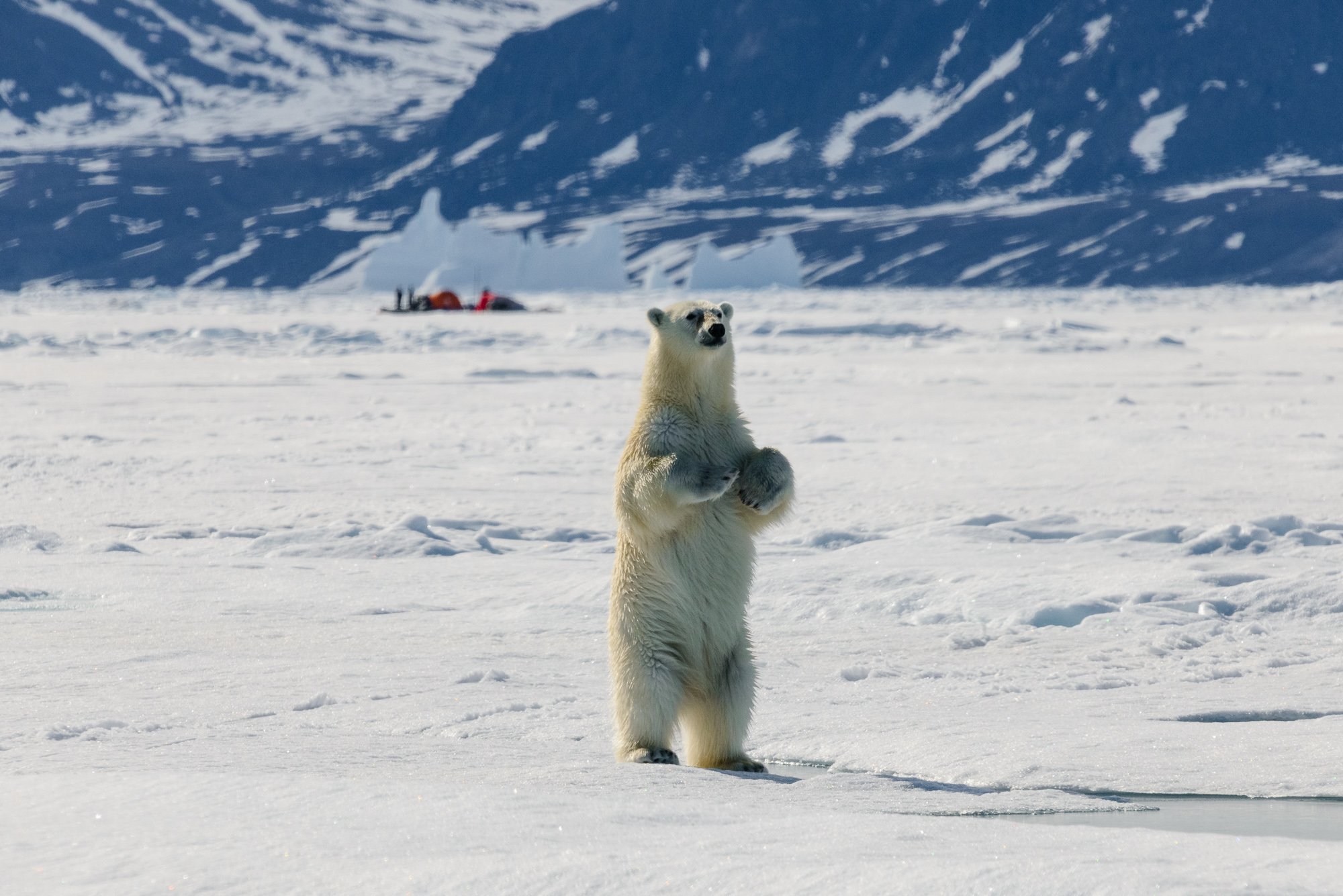
Complex and Dynamic Relationships
Baffin Island Floe Edge, Nunavut, Canada, 2013
A polar bear at the floe edge — the place where the shore-fast sea ice meets the open Arctic Ocean — pays a visit to an Inuit narwhal hunting camp. Both the bears and the Inuit use the sea ice as a place to travel and to hunt, and interractions are frequent.
With thousands of years of experience, Inuit know that you need to have the proper attitude, and a tremendous skill set, to live safely and comfortably in the sea ice environment. If you aren’t situationally aware, if you aren’t paying attention to your surroundings, if you don’t understand how everything impacts everything else, you can easily find yourself in the wrong place at the wrong time.
Wherever people live today, the climate no longer cares if they are deep in the wilderness or in the heart of a city. The paradigm has changed in the last decade or so, and urban centers with tens of thousands of people are now regularly engulfed in wildfires and battered by superstorms. The protective illusion of the built environment has been breached by our own actions.
Regardless of where we are, we need to invest in and acquire a deep body of cultural and ecological knowledge to survive. We need to understand complex, dynamic relationships. We need wisdom.
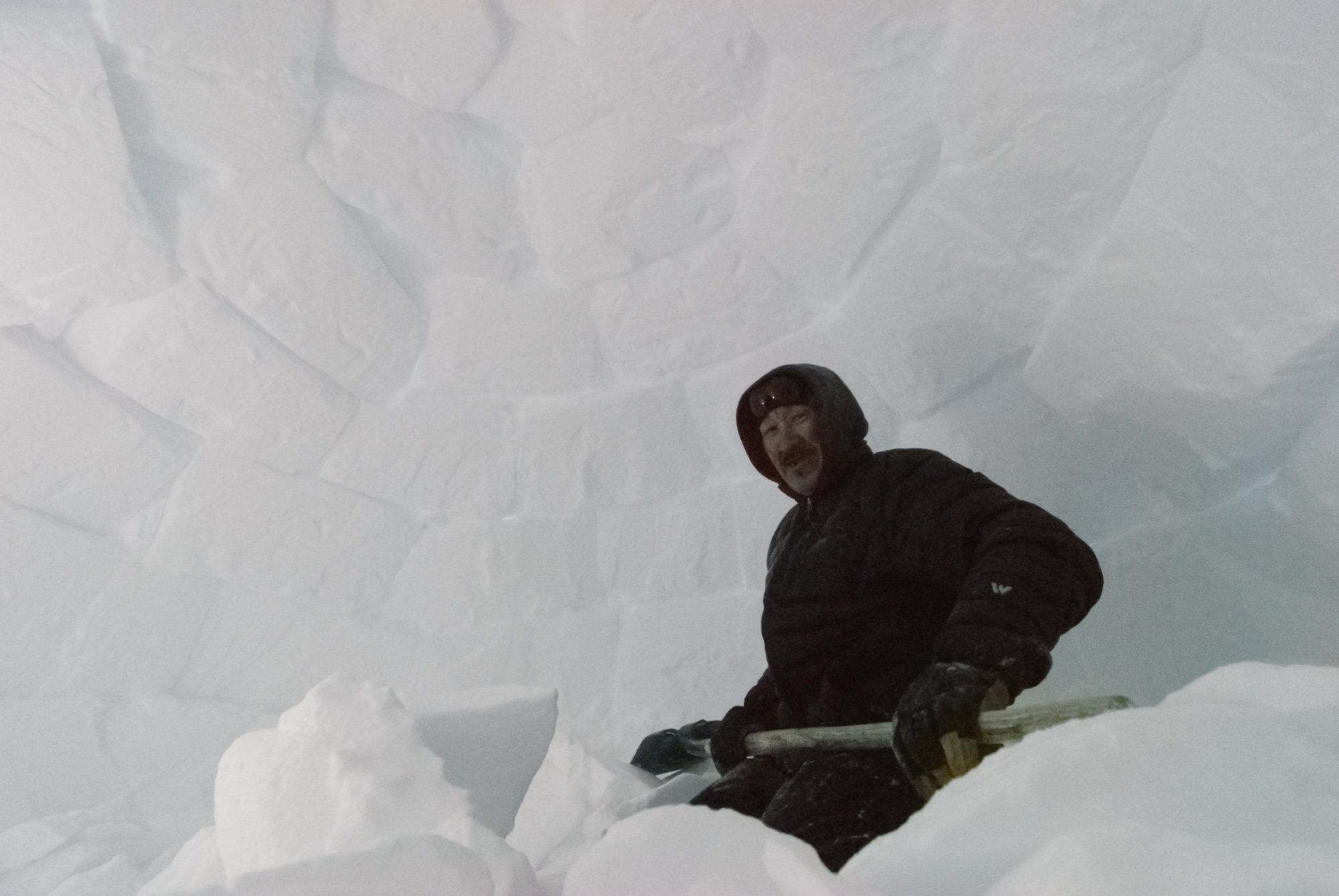
Sharing Conciousness With Nature
Puvirnituq, Nunavik, 2011
To thrive in their challenging Arctic homeland, Inuit rely upon the wisdom and guidance of traditional knowledge passed down for millennia. This traditional ecological and adaptive knowledge, called Inuit Qaujimajatuqangit in Inuktitut, includes not only a road map for navigating the physical landscape, but also guidance for safely negotiating the spiritual landscape as well. For Inuit the two are the same, encompassed by a sentient, animate, mystic power permeating all of existence they call Sila.
Sila connects people to the land, sea, and atmosphere; to the natural order of things; to the life-giving elements; and a person without Sila is thought to lack an essential relationship with the universe that is necessary for all human well-being.
I have heard Sila described this way:
“Sila is our concept for the weather, the climate, the mind, consciousness. It is the universal order where man is in unity with nature. Sila is the shared life that the sea, wind, mountains, animals, and humans possess. When you share consciousness with nature you treat nature with respect.”

Holding The Line
Finnmark Plateau, Arctic Norway, 2022
Each day brings dispiriting news about the state of the earth: melting ice sheets, rising sea levels, diminished food and water supplies, deforestation and desertification, growing inequality and wealth disparity, and mass extinctions of plant and animal species. It should come as no surprise that this unfolding planetary emergency is occurring as modern industrial society has all but severed its ties with the natural world.
The accelerating diminishment of personal as well as cultural knowledge about nature’s vital role in human sustenance and security undermines modern society’s ability to make well-informed decisions regarding natural resources. Traditional cultures such as Sami and Inuit provide critical bulwarks against further environmental deterioration and loss of ecological knowledge. The stories they tell guide them to live lightly upon the land, their home.
"What matters is the potency of a belief, the manner in which a conviction plays out in the day-to-day lives of a people, for in a very real sense this determines the ecological footprint of a culture, the impact that any society has on its environment. A child raised to believe that a mountain is the abode of a protective spirit will be a profoundly different human being from a youth brought up to believe that a mountain is an inert mass of rock ready to be mined." - Wade Davis

Arriving in Qeqertat
Qeqertat, Thule, Greenland, 2017
Qeqertat is a village of approximately 20 people on the shore of Inglefield Fjord in far northern Greenland. The Inughuit, or Polar Inuit, who call this region home are one of the smallest indigenous groups in the world, with a population of just 800 people. In the Inughuit homeland snow machines are not permitted, and all winter travel is by dogsled.
Despite the increasingly corrosive intrusions of modern industrial society, many Indigenous and place-based peoples live in multi-generational, supportive, and classless communities in traditional homelands. They pursue the ways of life they love, make well-designed tools with their own hands, see little distinction between social life and economic life, enjoy ample leisure time and affluence, and have a negligible impact upon the environment. They are modern, stable societies with healthy living traditions, and they pose a serious challenge to the ethnocentric, orthodox worldview of modern industrial society. Stepping outside of our culture and into theirs is revealing; the contrast is stark.
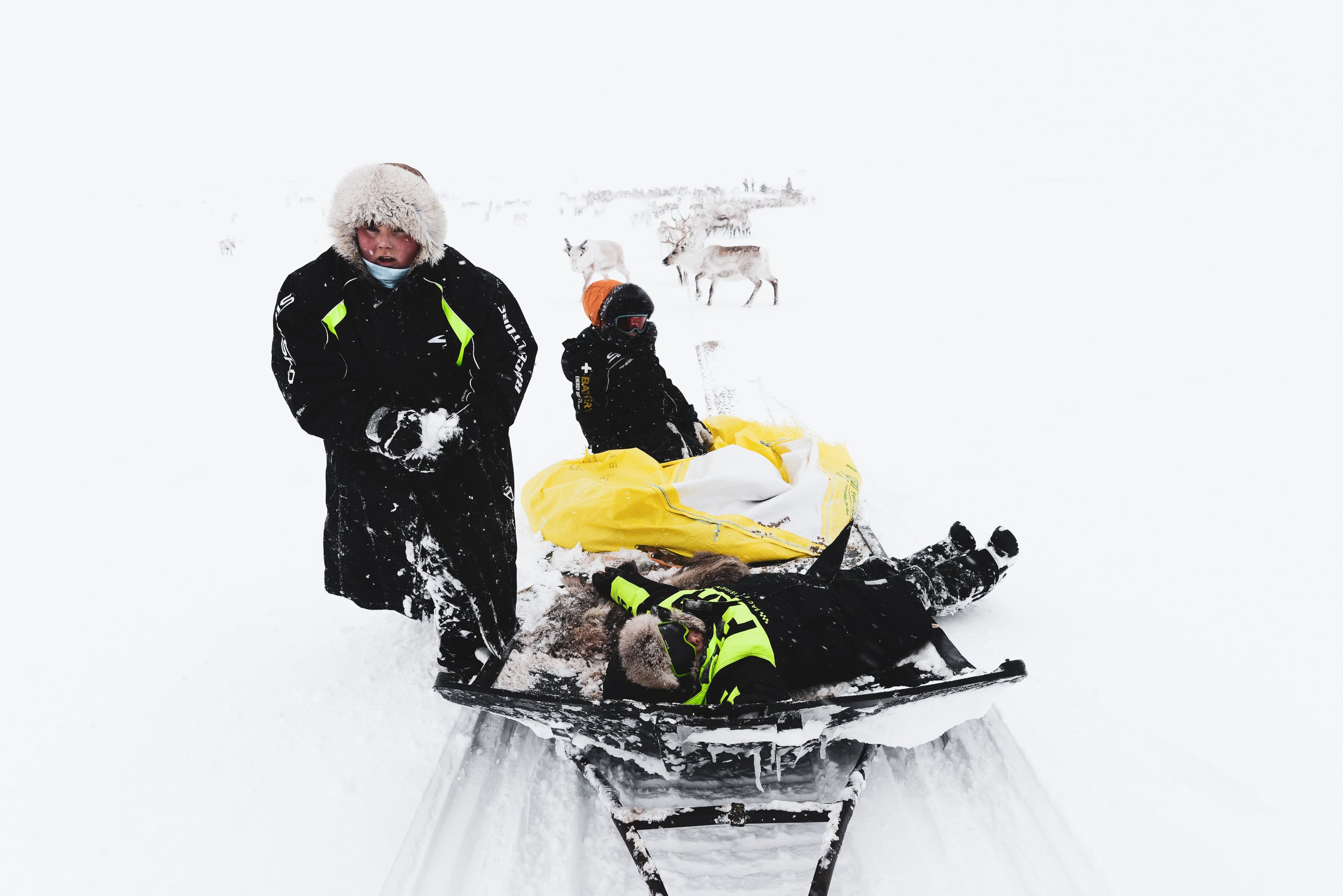
Just Being Kids
Finnmark Plateau, Arctic Norway, 2022
Sami kids on the migration go back and forth from home and school in town to join their father in his mobile camp on the plateau. Out on the land they have the time to absorb their cultural heritage and also to just be kids, throwing snowballs and going for sled rides. But their elders worry that the days of the traditional Sami way of life are numbered. A clear example of ongoing colonization of their lands, Sami activists say, is Norway’s largest onshore industrial wind energy project, Fosen Vind.
In 2021, the Norwegian Supreme Court ruled that parts of Fosen Vind had been built illegally on Sami reindeer herding territory, endangering the traditional livelihoods of Sami herders. The Supreme Court ordered the removal of the project. Despite the court’s ruling, the Norwegian government has made no moves to enforce the ruling and restore the land to the Sami, despite the clear legal obligation to do so.
If things don't change, reindeer herder Niilas Sara told me during the migration, the traditional Sami way of life will be gone within fifty years. This echoed a similar prediction for the Inughuit dog sled culture that I heard from the hunters while on expedition in northern Greenland.
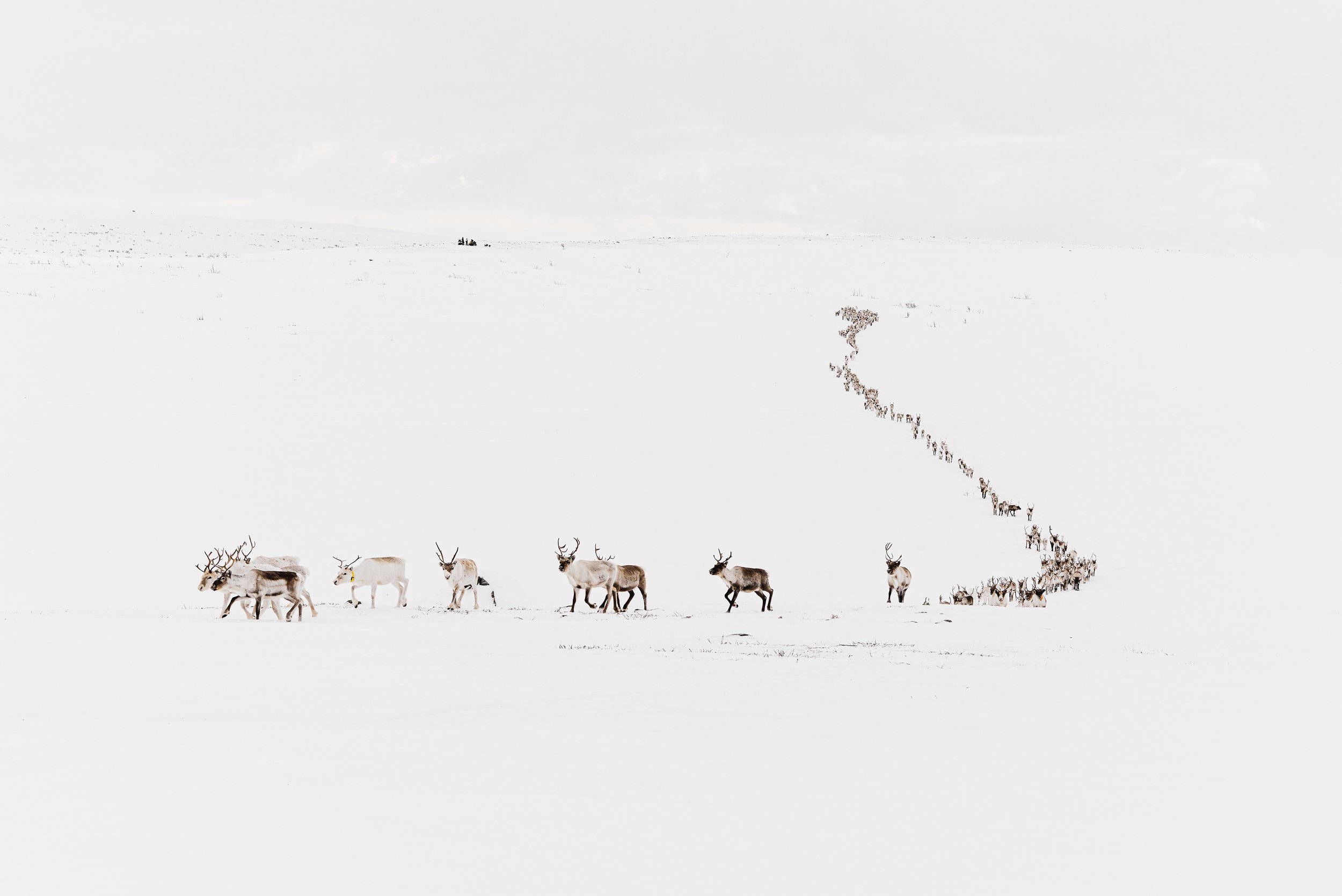
Democratic and Autocratic Technologies
Finnmark Plateau, Arctic Norway, 2022
As they have since time immemorial, Sami herders watch their reindeer migrate across the vastness of the Finnmark Plateau in Arctic Norway.
In 1963 Lewis Muford, American historian, sociologist, and philosopher of technology, wrote, "What I would call democratic technics is the small scale method of production, resting mainly on human skill and animal energy but always, even when employing machines, remaining under the active direction of the craftsman or the farmer, each group developing its own gifts, through appropriate arts and social ceremonies, as well as making discreet use of the gifts of nature..."
And then Mumford asks,
"Why has our age surrendered so easily to the controllers, the manipulators, the conditioners of an authoritarian technics?"
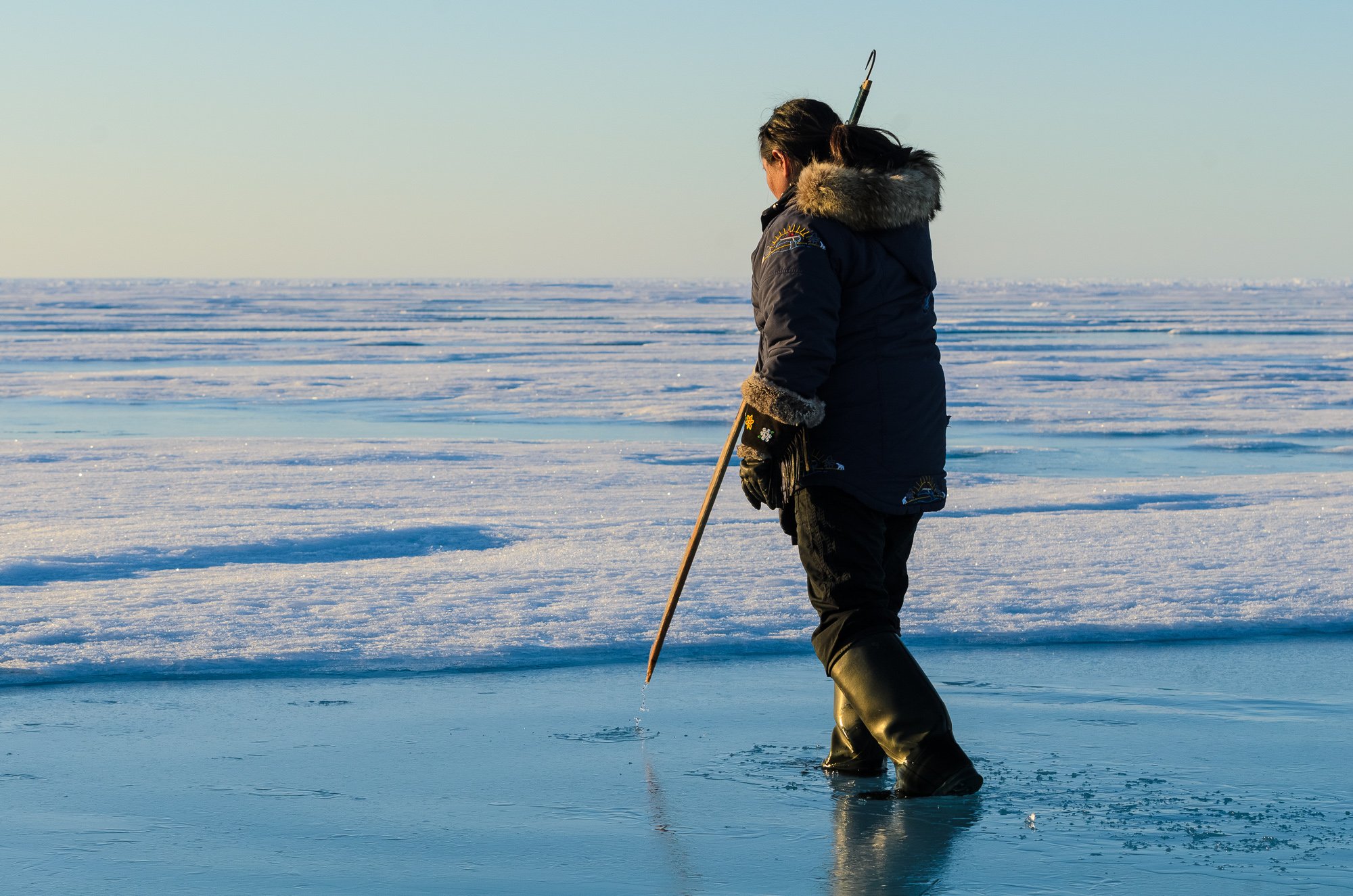
Culture is an Authentic, Original Response to a Specific Place.
Baffin Island Floe Edge, Nunavut, Canada, 2013
By relocalizing, by relearning who and where we are, we will be able to renegotiate our relationships with the land and with each other. Science plainly shows that ecosystems are not interchangeable, and neither are the place-based traditional ways of living in those ecosystems.
Culture is an authentic, original response to a specific place. When we see the land as the place where we are from, where we belong, and where future generations will thrive, we will know how to take care of it. By relocalizing, or as Vine Deloria Jr. and Daniel Wildcat put it, “indigenizing”, we will develop “elegantly designed solutions to living well that are predicated upon the uniqueness of place”, as David Orr says.

Technology, Modernity, and Design
Thule, Greenland, 2017
A modern 21st century Inughuit hunter rests his dogsled team while traveling over the sea ice near 80 degrees North in Greenland. The technology he uses, from his dogs to his sled to his clothing, is designed to function perfectly in his home environment. Using these tools does not make him an anachronism, he simply has no desire to trade what works well for what Western industrial society considers more modern — and would very much like to sell to him for a price he would prefer not to pay.
Western industrial society might not consider him modern because we confuse modernity with putting distance between ourselves, the land, and the sources of our sustenance. We also confuse modern technology with good design. Modern technologies are increasingly complex and reliant on computer software that makes them unfamiliar, hard to use, and hard to control. Good design, on the other hand, is the art of taking something familiar and useful and adapting it to contemporary situations as the need arises.
“Where good design becomes part of the social fabric at all levels, unanticipated positive side effects multiply,” says David Orr. “When people fail to design carefully, lovingly, and competently, unwanted side effects and disasters multiply. By the evidence of pollution, violence, social decay, and waste all around us, we have designed things badly.”
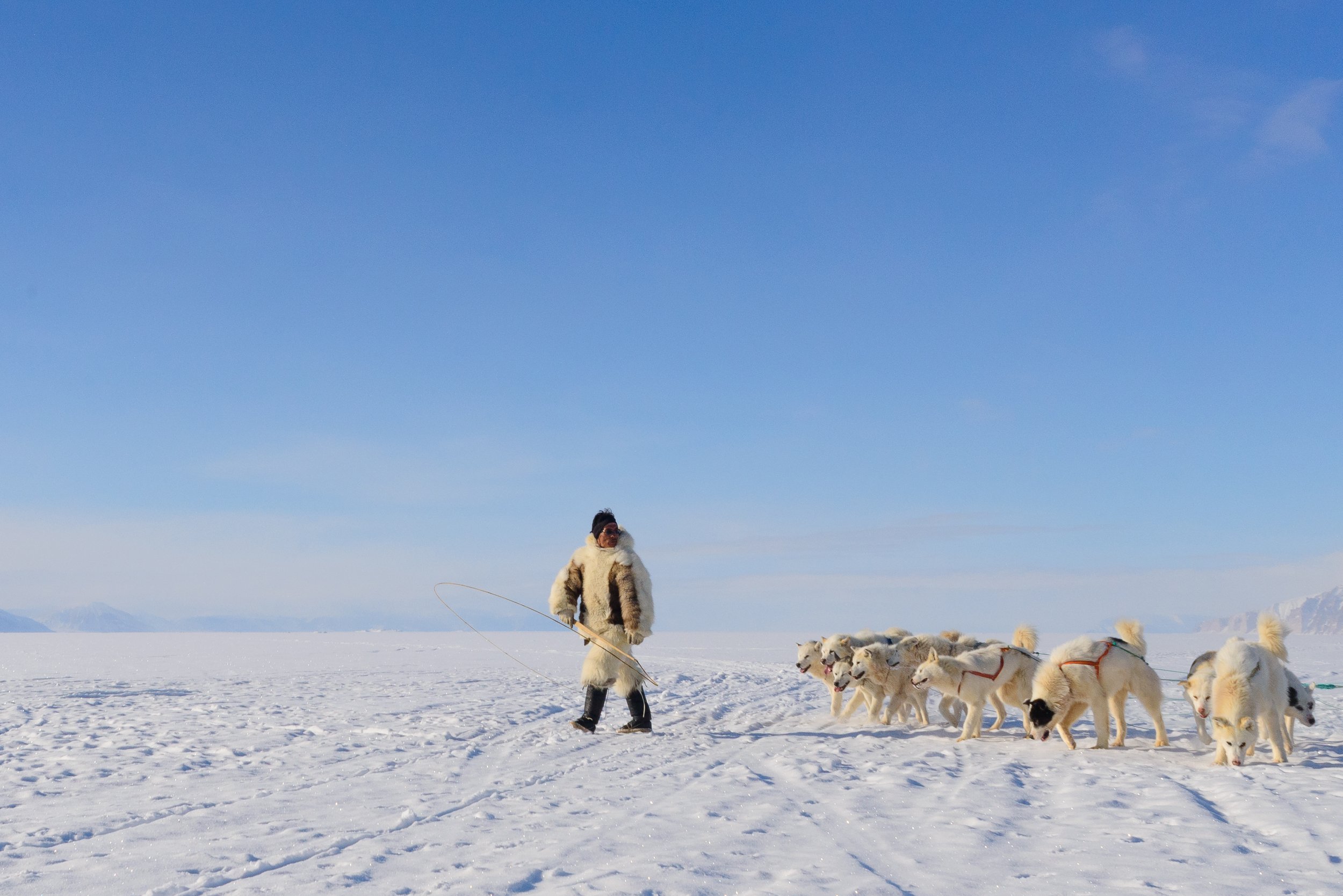
Locally Specific, Universally Relevant
Thule, Greenland, 2017
Indigenous peoples throughout the Arctic posses detailed and highly complex knowledge of the natural world gained through first-hand experience and then passed on from generation to generation. This traditional ecological knowledge has allowed them to sustainably benefit from highly productive ecosystems for thousands of years, and it provides a solid foundation for cultural, spiritual, and ethical guidance in the use of appropriate technologies and management of natural resources. This knowledge is locally specific, but the priciples are universal.

Gratitude and Reverence
Finnmark Plateau, Arctic Norway, 2022
In a moment of gratitude and perhaps even reverence, a Sami woman kneels in the snow before one of her reindeer, who returns her gaze. Inuit and Sami teach us that our challenge is not material or technical, it is cultural and spiritual.
In order to begin healing the planet and ourselves, they suggest, we need to see ourselves as of this land, our native home. Once we revere the land, we will treat it with respect. When we revere the land and the local land-based traditions that are our heritage, we will engage with the land and live resiliently, because the way we will live is wise, sustainable, and time-tested over many generations.
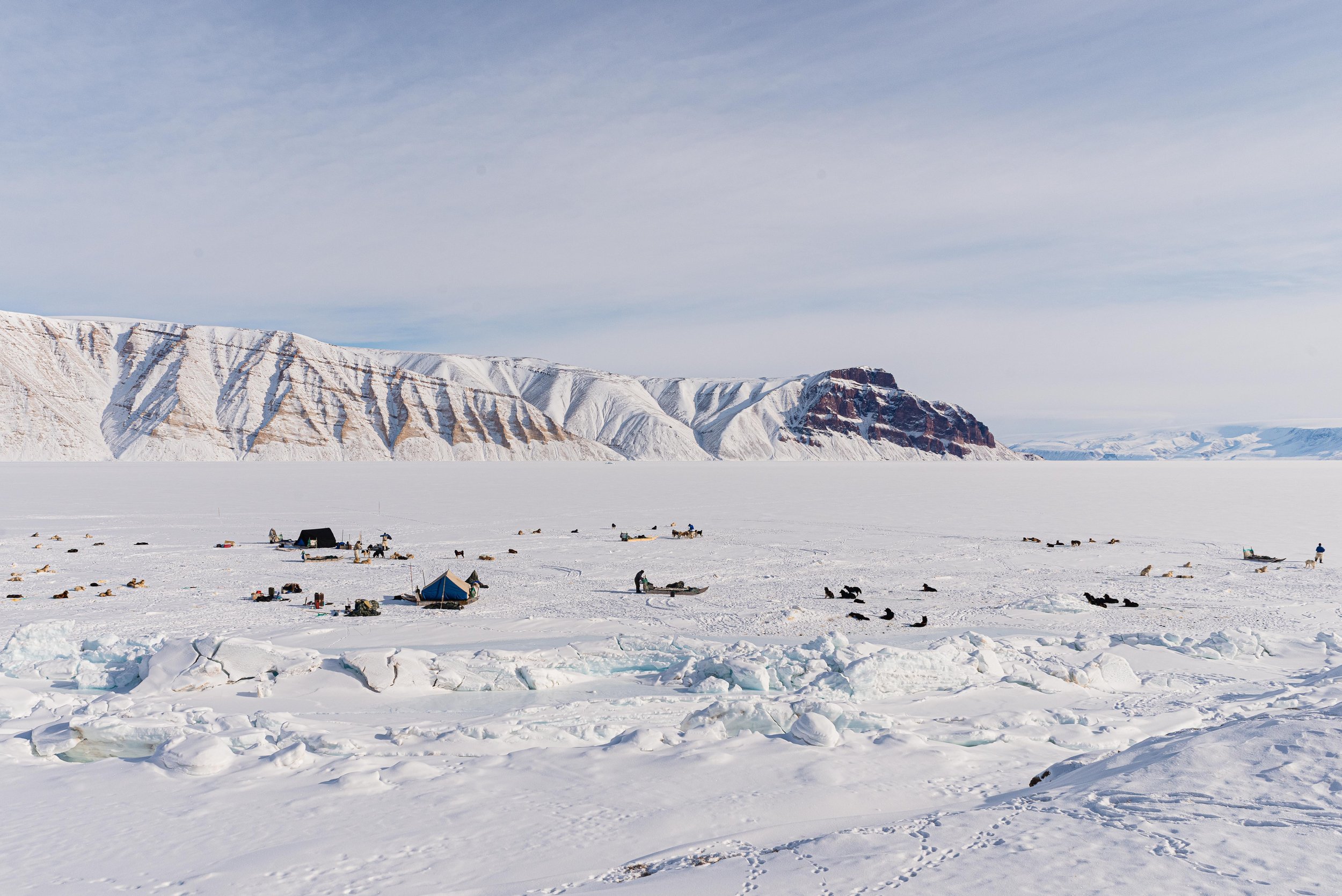
Time to Come Home
Thule, Greenland, 2017
In a timeless scene, Inughuit hunters set up camp on the sea ice as they have for countless generations. In contrast to modern industrial society’s long history as transient conquerors and exploiters, cultures such as Inuit and Sami offer us another way of seeing ourselves in the world going forward. We simply can no longer afford to view ourselves as homeless outsiders in abstract non-places, here to enrich ourselves at the land’s expense; or see the land as merely a limitless treasure chest of lifeless commodities to exploit. Nature is our home, and, as Simone Weil wrote, “To be rooted is perhaps the most important and least recognized need of the human soul.”
Rather than behave as cosmic outlaws, by following the examples of Inuit and Sami we might instead root ourselves in space and time. All people need a sense of belonging to something that is bigger than they are, and we underestimate that deep human need at our peril.
Many of us have allowed ourselves to become deracinated, but when we look around we see there are myriad ways to put down roots and pursue ways of living that are appropriate for the specific environments we inhabit. All the evidence suggests that it’s time to come home.

There are Many Paths
Thule, Greenland, 2017
We have hit the limits to growth. The cheap and abundant energy and materials that have powered Western industrial civilization for the last century and a half are in terminal decline, as is the planet’s ability to absorb our waste. As a result a great simplification is coming. One way or another, we will have to manage a return to a lower energy, lower materials input way of living. That is the reality of living on a planet of finite natural resources. This has nothing to do with human ingenuity, it is simply pure physics, biology, and geology. We can ignore reality all we like, but reality never goes away.
There is so much we can do. As Daniel Wildcat, a professor at Haskell Indian Nations University and a member of the Muscogee Nation of Oklahoma says, “There are many paths, each situated in the actual places, such as prairies, forests, deserts, and so forth, and environments where our tribal societies and cultures emerged. The experiences of time and history are shaped by places. This is not a pre-or-postmodernist or deep ecologist position. It is an indigenous realist position, one that increasing numbers of ecologists, such as Wes Jackson at The Land Institute, are recognizing as crucial if we human beings are to learn how to live in healthy sustainable communities utilizing appropriate technologies.”

Heading Home
Finnmark Plateau, Arctic Norway, 2022
Sami reindeer herders head back to migration camp immersed in a total whiteout. In a true whiteout such as this, the horizon disappears and both the sky and all landscape features vanish. There are no points of visual reference by which to navigate; even shadows disappear because the light arrives in equal measure from all directions. There is no up or down, no forward or backward. Being in a whiteout is like floating inside an opaque white room.
A whiteout is completely disorienting, most people suffer from vertigo in these conditions, and yet Sami know exactly where they are and how to get home.
Many in modern industrial society find themselves rootless and directionless, as though lost in a dizzying whiteout. Trying to navigate our complex circumstances we are confused, unsure of who and where we are, and unable to find our way home.
To get there we need all the help we can get. We need new stories, new narratives, and new guides to lead us back. We need inspiration and imagination, and we need an enlarged sense of what’s possible.













































